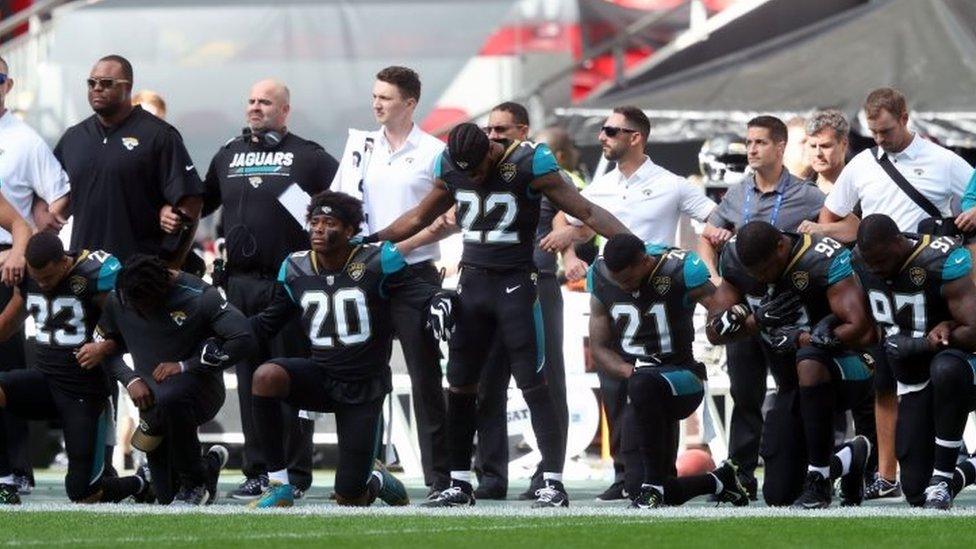Anthem protest: How diverse is the NFL?
- Published
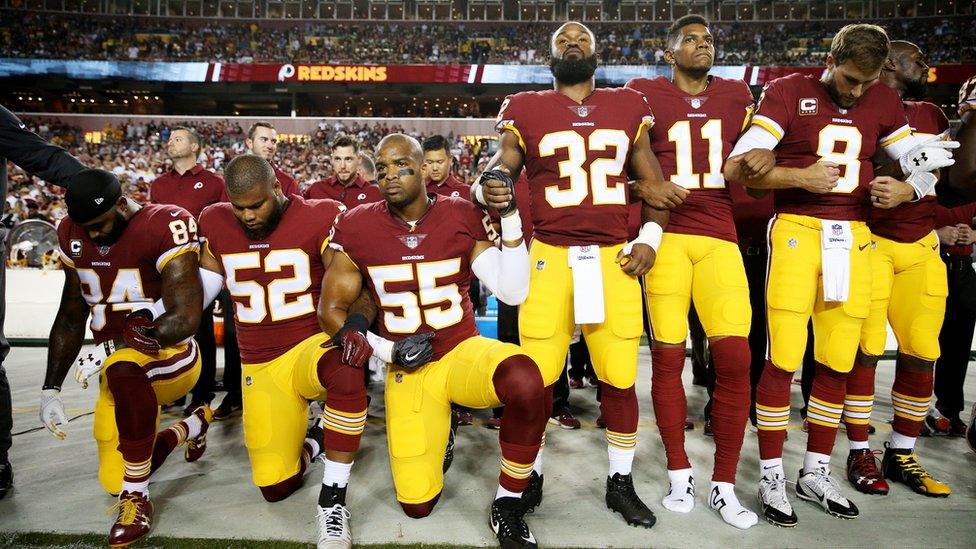
America's National Football League (NFL) says it plans to fine teams if their players kneel during the national anthem.
The form of protest, known as "taking a knee", has seen sports stars refuse to stand for the anthem, to highlight what they see as police brutality against African Americans.
The new rules were approved by the team owners at the spring meeting.
Some twitter users highlighted that while most of the NFL owners are white, most of the players are black.
Allow X content?
This article contains content provided by X. We ask for your permission before anything is loaded, as they may be using cookies and other technologies. You may want to read X’s cookie policy, external and privacy policy, external before accepting. To view this content choose ‘accept and continue’.
Allow X content?
This article contains content provided by X. We ask for your permission before anything is loaded, as they may be using cookies and other technologies. You may want to read X’s cookie policy, external and privacy policy, external before accepting. To view this content choose ‘accept and continue’.
So what is the racial make-up of the NFL and how does it compare with other US sports?
Back in August 2016, Colin Kaepernick, a player for the San Francisco 49ers, knelt during the national anthem.
Since then, players across the country have done the same during the rendition of the Star-spangled Banner. Other players have linked arms, sat on the bench, stayed in the locker room or raised a fist.
Under the new rules, the NFL will fine clubs "if its personnel are on the field and do not stand and show respect for the flag and the anthem". The league said players who do not want to stand can stay in the locker room until it has been performed. The NFL also reaffirmed a strong commitment to advance social justice.
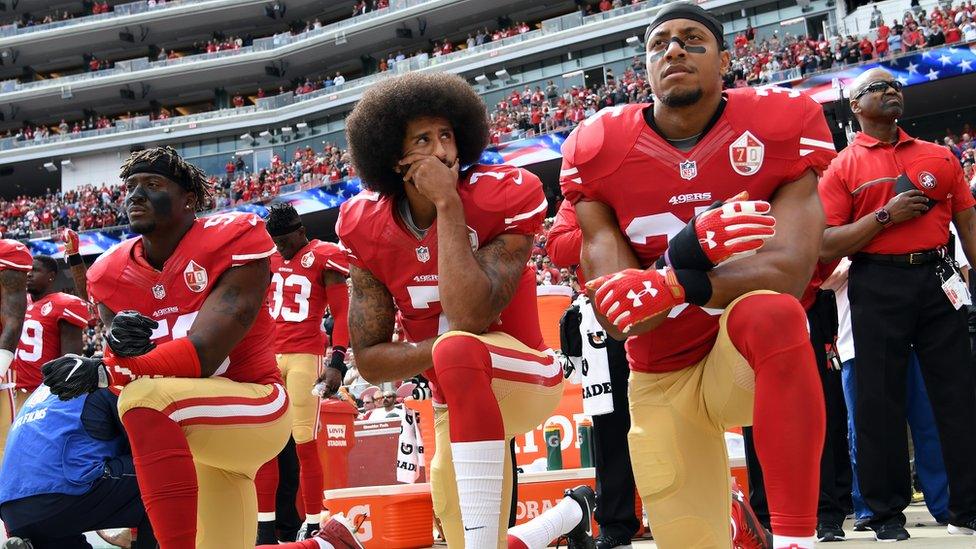
Colin Kaepernick (C) kneeling during the anthem before a game against the Dallas Cowboys
Diversity in the NFL
Each year the Institute for Diversity and Ethics in Sport, at the University of Central Florida, reports on diversity in the NFL - the players, coaches, officials and owners.
The report graded the NFL an A for its racial hiring practices.
It found that 70% of the players in 2016 were African-American (more than 1,500 athletes), nearly 30% were white and a small number Latino, Asian or from the Pacific Islands.
According to the report there were two NFL teams, out of 32, with a majority owner who was not white: Shahid Khan, a Pakistani-born American of the Jacksonville Jaguars and Kim Pegula, an Asian American woman, of the Buffalo Bills.

At the start of the 2017 season there were seven African-American head coaches.
The Rooney Rule, introduced in 2003, requires teams to interview at least one ethnic minority candidate for each head coach or senior football operation vacancy. The proportion of ethnic minority head coaches has remained fairly consistent since then.
How does it compare with basketball?
Like the NFL, most players in the National Basketball Association (NBA) are African-American.
About three-quarters of players in the 2016-17 season were African-American and about 19% were white.
Out of 32 teams, there were three owners of basketball teams from a minority group. It was the first time three people from black and ethnic minority groups have led teams in a major US professional sports league, according to the report.

Los Angeles Sparks players stayed in the locker room during the national anthem before a WNBA game against the Minnesota Lynx
Michael Jordan was the majority owner of the Charlotte Hornets, Vivek Ranadive, from India, was the "controlling owner" of the Sacramento Kings and Marc Lasry, born in Morocco, is an owner of the Milwaukee Bucks.
In the 2016-17 season there were 21 white coaches, six African-American coaches, one Asian, one Latino and one that identified as other.
The NBA also received an A for its racial hiring practices.
'Our country was founded on protest'
Coaches and players have spoken out in support of the protesting American footballers.
Steve Kerr, the coach of the Golden State Warriors, called the new NFL rules "idiotic" and said he was proud to be in a league that "understands patriotism in America is about free speech and about peacefully protesting".
Stan Van Gundy, coach of the Detroit Pistons, has also spoken out in support of protesting athletes. In October 2017 he said, external: "Our country was founded on protest. Otherwise, we would still be a colony of England."
NBA rules state that players are required to "line up in a dignified posture along the sidelines or on the foul line" during the anthem. And the league's commissioner Adam Silver has said that he expects players to stand during the national anthem.

Baseball catcher Bruce Maxwell of the Oakland Athletics
Stars like LeBron James have spoken publicly about police shootings, and teams have locked arms during the anthem.
The Women's NBA fined three clubs for wearing T-shirts in support of the Black Lives Matter movement during the warm-up. The fines were later rescinded.
What about baseball?
Baseball players are predominantly white. In the 2017 Major League Baseball, external (MLB) season, 58% of the players were white, 32% were Latino and 8% were African-American. It received a B grade from the diversity report.
Arturo Moreno, who owns the Los Angeles Angels, is the only owner of an MLB club from a minority. In the 2016 season, 45% of coaching positions were held by people from a black and ethnic minority background.
In September 2017, Oakland Athletics catcher Bruce Maxwell, an African-American, was the first and only baseball player to kneel during the national anthem.



- Published23 May 2018
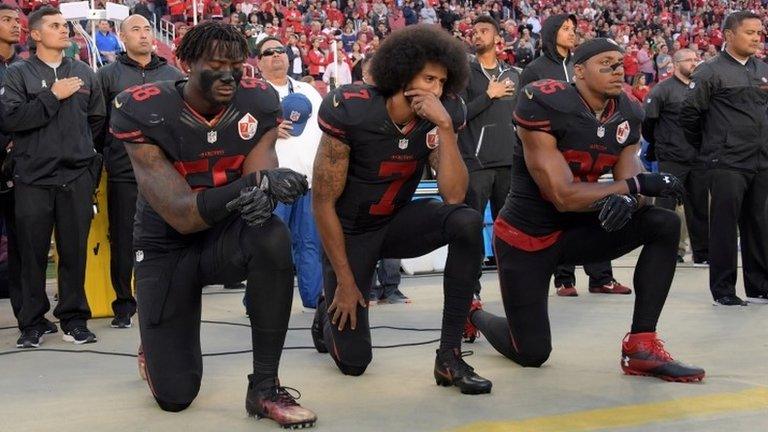
- Attribution
- Published11 October 2017
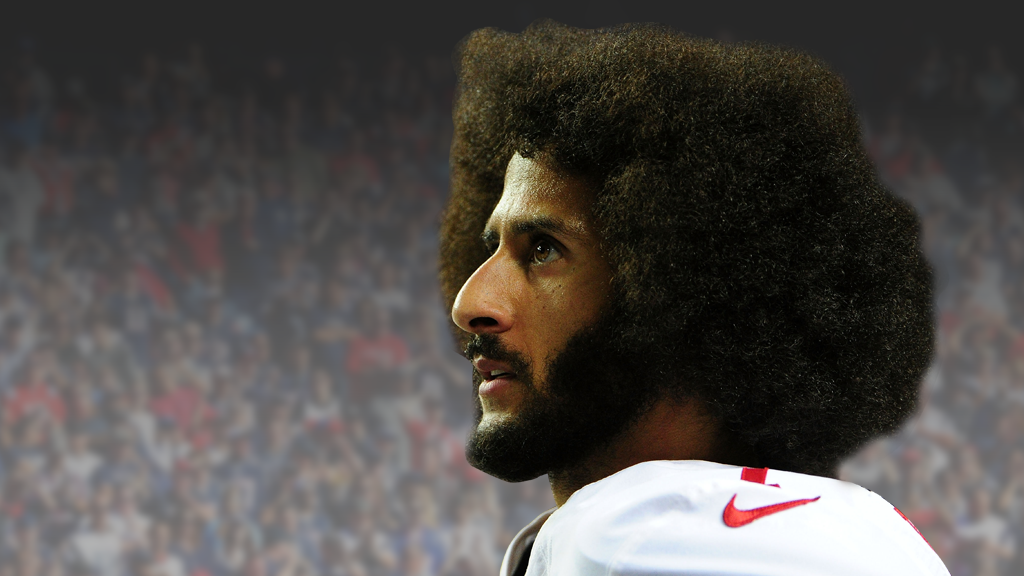
- Published25 September 2017
